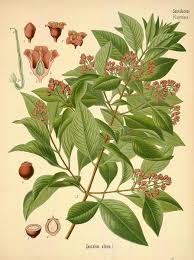Sandalwood (Santalum album) is a small, tropical evergreen tree with leathery leaves and clusters of tiny purple flowers. The tree is semi-parasitic, its roots penetrating lose of neighbouring plants, especially bamboo and palms. For several years the young tree depends on other plants for nourishment - eventually draining its hosts to death.

Native to southern Asia, most of the world's supply of sandalwood is grown in the Mysore region of eastern India.
Mature trees of 20-50 years old are used for the essential oil, which is found in the roots and heartwood. The bark of the roots and trunk, and the outer sapwood and branches are removed. The heartwood is sawn into logs 90-120cm long, dried and stored. The oil is then extracted from the logs and dried roots by steam distillation. The forestry management system uses saplings grown on plantations to replenish stocks in the forest, where the trees are felled.
The oil is a yellowish, slightly sticky liquid. The aroma is sweet, woody and balsamic with a musky undertone - and is deeply relaxing, soothing and sensual. Unlike most oils, the scent of sandalwood improves with age. Highly prized by perfumers for its long-lasting fragrance, it is frequently used as a base note and fixative.
Finding the Quality
To buy a good-quality pure sandalwood oil, your first step is to look for assurance that it comes from Mysore or a label that has the wording 'Agmark' or 'Agmark type'. Alternatively, a supplier may provide a separate write-up about the oil's origin. A reputable supplier will also analyse the material batch by batch to ensure its purity and quality.
Sandalwood oil has increased in price by more than 400% over the past few years due to its scarcity and the tight controls imposed by the Indian government, so it's especially vulnerable to adulteration. Unfortunately, some illegal oil shipped from India has found its way on to the Indonesian market, and is being sold cheaply. Australian sandalwood oil (Santalum spicatum) is a less expensive alternative to Indian sandalwood, but has less value medicinally and an inferior aroma, lacking the soft, sweet top notes characteristic of its exotic cousin. Sandalwood (or amyris) from the West Indies (Amyris balsamifera) is botanically unrelated, although its essential oil is sometimes sold as a cheap alternative to S. album. Quite apart from its harsh, smoky aroma, the oil is thought to have a little medical value.
History of Sandalwood

For centuries sandalwood has played a prominent role in the cultural and spiritual life of Asia. The wood was carved into furniture, temples and religious objects, and is still burned as incense in Buddhist and Hindu temples.
It's also used to anoint and embalm the dead, in the belief that it protects the soul as it enters the next life.
Sandalwood has a dual nature - at times cooling and meditative and at others sensual. The ancient Hindus were well aware of its erotic overtones, and Indian courtesans rubbed their breasts with sandalwood paste mixed with musk to increase their allure. Interestingly, modern research has shown that the oil contains a steroid-like substance with a similar chemistry to testosterone, the hormone that is believed to drive the libido in both men and women. For centuries in India, sandalwood combined with rose otto has formed the basis of an aphrodisiac perfume known as aytar.
Practitioners of Ayurvedic (traditional Indian) medicine have always valued sandalwood for its healing properties. A paste made from the powered heartwood is used for skin ulcers, abscesses and tumours. European medical herbalists formerly prescribed internal doses of the fluid extract (prepared from the powdered heartwood) for ailments such as chronic bronchitis and cystitis.
Sandalwood used to be known as santal, saunders or sanders. In many old herbals the wood chips or powder appear as an ingredient in moth-repellent sachets and potpourris. In wealthy Victorian homes, sheets and pillowcases would be kept in a carved sandalwood chest. The linen took on the fragrance of the wood, which kept moths away and promoted peaceful sleep.
Properties of the Essential Oil
Modern research has confirmed that the oil has antifungal, anti-inflammatory, astringent, expectorant, bactericidal, insecticidal, antiseptic (especially of the urinary and respiratory systems), fever-reducing and sedative properties.
Aromatherapists use sandalwood as a supportive remedy for certain forms of depression, particularly where there is also anxiety and insomnia. For skin care, the oil is equally effective for both dry and greasy skin and has also proved helpful for acne, eczema (but only under the supervision of a clinical aromatherapist), abscesses, cracked and chapped skin. It is extremely soothing and can help smooth the appearance of dry, more mature skin.
When used in steam inhalations and applied to the chest and throat (diluted in a carrier oil), sandalwood is an excellent remedy for persistent coughs, bronchitis and laryngitis. A tine amount in a gargle is beneficial for a sore throat (making sure the gargle is spat out afterwards). As a supportive remedy for cystitis, it can be used in a sitz bath, normal bath ot on a warm compress to help relieve discomfort.
Sandalwood is a wonderful oil for soothing a frantic nervous system and setting the mood for romance. Its deep, woody aroma is especially appreciated by men.